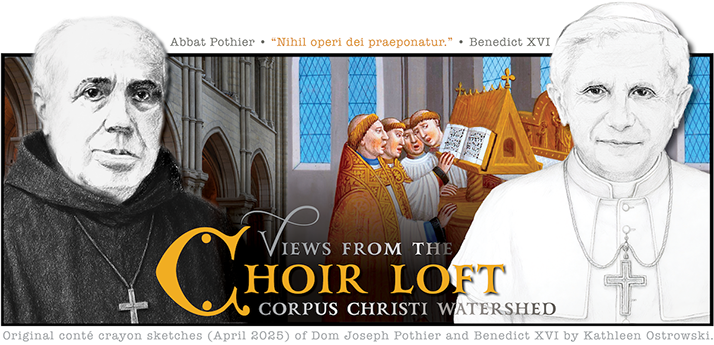ON SUNDAY mornings, my first service at my parish is the English Mass in the new rite. During the Covid pandemic, the schedule got shuffled around, and we also changed the music at this Mass to be all Gregorian. The small choir we had before the pandemic has also been disbanded, so I am by myself on these occasions. The congregation sings the Mass ordinary well (a rotation of Masses 1, 8, 11, and 17 with Credos 1 and 3 based on the season), but I sing the propers alone, with the texts provided for the faithful.
For this Mass, I usually sing from the Graduale Triplex. This accomplishes a few things. The main choral program at my parish is geared toward the Traditional Mass, and with my schola there I sing straight from the old Solesmes editions. So my time with the Triplex gives me a chance to study some of the adiastematic neumes associated with the chants. As readers who sing in both forms of the Roman Rite know, for much of the year the calendars are somewhat misaligned, even though the repertoire sung in both forms is substantially the same. I don’t really have strong feelings about a semiological performance style; I adjust some things slightly according to the neumes but my approach is mostly the same as in the other Mass: attention to the tonic accents and the melodic divisions and sense. Trying to be flexible about this keeps me from falling into a rut. Feelings run high about the performance of chant (as can be seen in many places on this blog), but changing some aspects of the style in different contexts keeps me in mind of the fact that each melody is a gift, a treasure, and a prayer.
This is all obvious to those of us formed by the Church’s teaching on the significance of Gregorian chant. But what I want to stress today is that it is always new; there is always something more to ponder or consider. One instance of this struck me the other day at the English Mass. The new Gradual has rather different propers for the Second Sunday of Lent, with many of the melodies rearranged presumably to emphasize the Transfiguration, which is the subject of the Gospel passage. The communion antiphon is Visionem, which in the old rite is sung on the feast of the Transfiguration. It is also (with the exception of one variant neume) sung as the Magnificat antiphon for first and second Vespers of the Second Sunday of Lent. Here is this rather beautiful melody, whose simplicity betrays its source in the office:

In this case, the adiastematic neumes come from the Hartker Antiphoner. The neumes reveal some niceties of the setting that don’t make it into the notation on the staff, viz., the “augmentative” liquescence on “quam,” the liquescence on the second syllable of “resurgat.” We also see a few melodic discrepancies, most notably at “nemini,” which suggests clearly that the first syllable should be on a higher pitch than what follows (in line with the tonic accent). These are all rather nice reasons to sing occasionally from the Triplex; I draw great fruit personally from studying these things, and perhaps the next time I meet this melody in another context, I will remember one or more of these little details.
But on this occasion, it was a detail of another kind that struck me most: the little melodic motive on “donec a mortuis.”

I was instantly reminded of the Eastertide hymn “O Filii et Filiae.”

That is not an “authentic” Gregorian melody, of course, but it clearly echoes the communion for Low Sunday, which is.

What’s the big deal? Why is it significant that these melodies share some seven notes? The answer lies in something that I want to share about why I find chant to be such a rewarding object for my musical thoughts and energy. I’ve sung this melody before over the years, both at Mass and Vespers. And this never occurred to me until the other day. There is always something new to think about, as we circle the liturgical seasons again and again. Chant scholars love to point out that the chant is, by and large, not expressive of the words. But it is full of these little melodic resonances. There is something beautiful about being a chant practitioner: we are not scholars in the usual sense but people who experience the act of prayer during our scholarly work (ora et labora). For this reason we can spiritualize these little melodic resonances and exegete them to our hearts’ content.
In Visionem, we hear the words of the Lord, telling Peter, James, and John not to tell anyone about their vision until after Christ’s rising from the dead. At precisely the moment of the mention of the rising from the dead, we get a little melodic motive that strikes the ear (or at least my ear) as a reminder of these other melodies about having faith in the resurrection. We get a little foretaste here of Easter melodies, just as the Transfiguration is a foretaste of the glory manifested by the risen Lord after the first Easter. Is this an accident? Perhaps. But it is no less significant; the praying cantor can certainly draw musical and textual significance out of it. Each day, when we sing, we bring to the process our entire spiritual and musical formation, shaped by the unending cycle of liturgical melody. Approaching this rather simple antiphon during this rather modest celebration of the Mass, I found this to be a beautiful and fruitful moment, full of theological insight into the readings for the day. That kind of thing happens all the time in plainchant. It is truly a gift.

